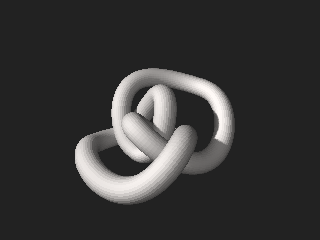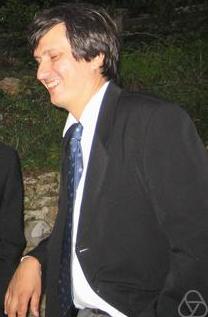Related Research Articles

Charles Sanders Peirce was an American scientist, mathematician, logician, and philosopher who is sometimes known as "the father of pragmatism". According to philosopher Paul Weiss, Peirce was "the most original and versatile of America's philosophers and America's greatest logician". Bertrand Russell wrote "he was one of the most original minds of the later nineteenth century and certainly the greatest American thinker ever".

In geometry, a polyhedron is a three-dimensional figure with flat polygonal faces, straight edges and sharp corners or vertices.

Topology is the branch of mathematics concerned with the properties of a geometric object that are preserved under continuous deformations, such as stretching, twisting, crumpling, and bending; that is, without closing holes, opening holes, tearing, gluing, or passing through itself.
In mathematics, a topological space is, roughly speaking, a geometrical space in which closeness is defined but cannot necessarily be measured by a numeric distance. More specifically, a topological space is a set whose elements are called points, along with an additional structure called a topology, which can be defined as a set of neighbourhoods for each point that satisfy some axioms formalizing the concept of closeness. There are several equivalent definitions of a topology, the most commonly used of which is the definition through open sets, which is easier than the others to manipulate.

Maxim Lvovich Kontsevich is a Russian and French mathematician and mathematical physicist. He is a professor at the Institut des Hautes Études Scientifiques and a distinguished professor at the University of Miami. He received the Henri Poincaré Prize in 1997, the Fields Medal in 1998, the Crafoord Prize in 2008, the Shaw Prize and Breakthrough Prize in Fundamental Physics in 2012, and the Breakthrough Prize in Mathematics in 2015.
In mathematics, and more specifically in algebraic topology and polyhedral combinatorics, the Euler characteristic is a topological invariant, a number that describes a topological space's shape or structure regardless of the way it is bent. It is commonly denoted by .

In topology, knot theory is the study of mathematical knots. While inspired by knots which appear in daily life, such as those in shoelaces and rope, a mathematical knot differs in that the ends are joined so it cannot be undone, the simplest knot being a ring. In mathematical language, a knot is an embedding of a circle in 3-dimensional Euclidean space, . Two mathematical knots are equivalent if one can be transformed into the other via a deformation of upon itself ; these transformations correspond to manipulations of a knotted string that do not involve cutting it or passing it through itself.

In the mathematical field of knot theory, a knot invariant is a quantity (in a broad sense) defined for each knot which is the same for equivalent knots. The equivalence is often given by ambient isotopy but can be given by homeomorphism. Some invariants are indeed numbers (algebraic), but invariants can range from the simple, such as a yes/no answer, to those as complex as a homology theory (for example, "a knot invariant is a rule that assigns to any knot K a quantity φ(K) such that if K and K' are equivalent then φ(K) = φ(K')."). Research on invariants is not only motivated by the basic problem of distinguishing one knot from another but also to understand fundamental properties of knots and their relations to other branches of mathematics. Knot invariants are thus used in knot classification, both in "enumeration" and "duplication removal".
A knot invariant is a quantity defined on the set of all knots, which takes the same value for any two equivalent knots. For example, a knot group is a knot invariant.
Typically a knot invariant is a combinatorial quantity defined on knot diagrams. Thus if two knot diagrams differ with respect to some knot invariant, they must represent different knots. However, as is generally the case with topological invariants, if two knot diagrams share the same values with respect to a [single] knot invariant, then we still cannot conclude that the knots are the same.
In mathematics, a distributive lattice is a lattice in which the operations of join and meet distribute over each other. The prototypical examples of such structures are collections of sets for which the lattice operations can be given by set union and intersection. Indeed, these lattices of sets describe the scenery completely: every distributive lattice is—up to isomorphism—given as such a lattice of sets.

In mathematics, triangulation describes the replacement of topological spaces by piecewise linear spaces, i.e. the choice of a homeomorphism in a suitable simplicial complex. Spaces being homeomorphic to a simplicial complex are called triangulable. Triangulation has various uses in different branches of mathematics, for instance in algebraic topology, in complex analysis or in modeling.

Johann Benedict Listing was a German mathematician.

In mathematics, a manifold is a topological space that locally resembles Euclidean space near each point. More precisely, an -dimensional manifold, or -manifold for short, is a topological space with the property that each point has a neighborhood that is homeomorphic to an open subset of -dimensional Euclidean space.

An existential graph is a type of diagrammatic or visual notation for logical expressions, created by Charles Sanders Peirce, who wrote on graphical logic as early as 1882, and continued to develop the method until his death in 1914. They include both a separate graphical notation for logical statements and a logical calculus, a formal system of rules of inference that can be used to derive new theorems from known ones.
In physics, a topological quantum number is any quantity, in a physical theory, that takes on only one of a discrete set of values, due to topological considerations. Most commonly, topological quantum numbers are topological invariants associated with topological defects or soliton-type solutions of some set of differential equations modeling a physical system, as the solitons themselves owe their stability to topological considerations. The specific "topological considerations" are usually due to the appearance of the fundamental group or a higher-dimensional homotopy group in the description of the problem, quite often because the boundary, on which the boundary conditions are specified, has a non-trivial homotopy group that is preserved by the differential equations. The topological quantum number of a solution is sometimes called the winding number of the solution, or, more precisely, it is the degree of a continuous mapping.

A slice knot is a mathematical knot in 3-dimensional space that bounds an embedded disk in 4-dimensional space.

Louis Hirsch Kauffman is an American mathematician, mathematical physicist, and professor of mathematics in the Department of Mathematics, Statistics, and Computer Science at the University of Illinois at Chicago. He does research in topology, knot theory, topological quantum field theory, quantum information theory, and diagrammatic and categorical mathematics. He is best known for the introduction and development of the bracket polynomial and the Kauffman polynomial.
The propensity theory of probability is a probability interpretation in which the probability is thought of as a physical propensity, disposition, or tendency of a given type of situation to yield an outcome of a certain kind, or to yield a long-run relative frequency of such an outcome.
In mathematics, specifically geometry and topology, the classification of manifolds is a basic question, about which much is known, and many open questions remain.
In topology and related areas of mathematics, a subset A of a topological space X is said to be dense in X if every point of X either belongs to A or else is arbitrarily "close" to a member of A — for instance, the rational numbers are a dense subset of the real numbers because every real number either is a rational number or has a rational number arbitrarily close to it. Formally, is dense in if the smallest closed subset of containing is itself.
References
- ↑ Peirce, Charles Sanders (1992), Reasoning and the Logic of Things: The Cambridge Conferences Lectures of 1898, Harvard University Press, Footnote 70, pp. 279–280, ISBN 9780674749672 .
- ↑ Peirce, pp. 99–102.
- ↑ Peirce, p. 99.